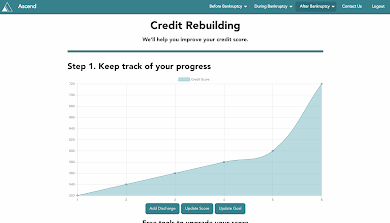
You now feel the financial freedom from credit card debt after filing for bankruptcy, but you may wonder whether you will be able to access credit again soon. The good news is that many people are able to access credit again.
Although the Chapter 7 bankruptcy is on your credit report for 10 years and the Chapter 13 bankruptcy remains on your credit report for 7 years, the impact of your score in relation to bankruptcy will fade over time. For example, there are often different time parameters for such actions as getting a house after bankruptcy vs getting a general loan after bankruptcy. You may not see those same, stringent guidelines for renting an apartment, but that may be more on a case-by-case basis.
You can often start rebuilding your credit soon after bankruptcy to become increasingly attractive to creditors to offer you credit once again. The purpose of this article is to:
One of the most important things about rebuilding your credit score after bankruptcy is the encouragement along the way to keep you going. You can use a Google spreadsheet or an excel document to manage your credit score increase or you could use the free portal that we build that helps you track your credit progress.
The credit rebuilding portal helps you track your credit progress, see how to fix common post bankruptcy credit reporting errors, and is 100% free. We built this portal because we

It's helpful for you to understand the both your credit report and credit score will be affected. Your credit report will have the bankruptcy filing information, and the credit score (number between 300-850) will also be affected. Let's get into the nuts and bolts.
While it is true that your credit score decreases when you file for bankruptcy relief, the decrease is temporary. You should understand that there is an immediete effect you should consider with bankruptcy. We ran a debt settlement credit score simulator based on myFICO's simulator to estimate debt settlement impact, but unfortunately, we could not do the same for bankruptcy.
Generally, the decrease in your credit score depends on your credit score when filing for Chapter 7. If your credit score is good, you may see a more substantial decrease in your credit score compared to someone whose credit score is much lower. By the time many people file for Chapter 7, their credit scores are already lower because of late payments and debt collections.
The good news is that many Chapter 7 debtors see an increase in their credit scores in as little as a year after filing bankruptcy. Each case is different, but there are some things you can do to help improve your credit score after bankruptcy.
A study by the Public Interest Research Group found that 29% of credit reports contained errors. You should definitely consider accessing your credit reports post filing bankruptcy. You can get free copies of your credit report from each of the three main bureaus: Equifax, Experian and TransUnion every 12 months. It is wise to review your credit reports each year and correct mistakes that hurt your score immediately.
Here are some things that you should look out for post bankruptcy on your credit report:
We are going to discuss new credit opportunity post filing for bankruptcy as well as other opportunities you have to improve your credit score after bankruptcy. You may want to consider timing from discharge when deciding whether to apply for new credit. Although minimal, hard credit enquiries can negatively affect your credit score.
As such, you want to be diligent when to apply for new credit to maximize your chances of obtaining credit without your credit score.
Secured credit cards can be useful for improving credit after Chapter 7. You must place a security deposit with the company to cover your charges, in case you default on payments. Use the card for small purchases and make all payments on time. However, before applying for a secured credit card, make sure that the company reports the account to the credit reporting agencies. If not, applying for the card will not help you improve your credit scores.
A mix of credit improves your credit score. After determining you have the funds in your monthly budget to afford an installment loan, consider a furniture loan or other installment loan. Be cautious when borrowing money after filing bankruptcy. You need to ensure you can afford the payments, or you could risk undoing the improvements you have worked so hard to make.
Similarly, store credit cards can be more easily available to help build your credit while potentially have looser restricts. These cards often have a lower balance as well. The challenge with these cards is to understand whether you would carry a balance on these cards.
I wanted to first discuss the new credit opportunities before diving into the other things to consider when rebuilding your credit. You can do these without applying for new credit cards or loans.
As stated above, all accounts discharged in bankruptcy should have a zero balance. In most cases, the accounts note that they were included in a bankruptcy. If an account that was discharged in your Chapter 7 is not correct, notify the creditor and the credit reporting agencies immediately. One of the benefits of discharging debts in Chapter 7 is that the accounts are closed, the balances owed are zero, and the company cannot report failure to make payments.
Here's a place where you can dispute incorrect items for each bureau:
Many people file bankruptcy due to a life event that affected the negatively, but are still credit responsible. As such, you can become a co-signer or authorized user that can help you rebuild. You are essentially able to utilize the card owners history, so if they pay on time and keep their balances low, your credit scores may rise. For this option, you may want to be careful who you choose.
One of the attributes about your credit score is your debt utilization rate. Your credit utilization rate is your total credit debt divided by the total credit available. Your credit utilization rate accounts for up to 30% of your credit score. When you start rebuilding, you will have a low credit available amount. Carrying a $0 balance will make that utilization rate quite low.
Pay all debt payments on time. Late and missed payments hurt your credit score quickly and substantially.
When you are financially stable, apply for store credit cards. These credit cards are generally easier to get than a major credit card. Beware, the interest rate may be high for a few years. It is best to charge small amounts and pay off those amounts quickly to avoid paying high interest rates. The purpose is not to use credit, but to pay it off timely to improve your credit scores.
When you create a budget, make sure that you contribute to an emergency fund each month. You may need to begin with a small amount, but remember to increase that amount as your finances improve. Having an emergency fund helps avoid incurring debt for unexpected expenses. USA.gov has information about credit reports and resources if you believe your legal rights have been violated. You may begin receiving offers for credit within months after completing your Chapter 7 case. Always remember to shop around for the lowest interest rate and best terms. However, avoid credit until you know you can afford the payments. Rushing into debt to improve credit scores before you are ready could result in low credit scores for much longer than is necessary.
NOTE: You can do all of the above things yourself. You do not need a company to help you improve your credit score. Offers to improve your credit score after bankruptcy are often scams. Some companies may use unethical or even illegal ways to improve your score. It is best to put in the work and time to improve your credit rating after Chapter 7 instead of trying to take a short cut.
One of the most helpful things for me is to read actual stories about people who went through bankruptcy and are now on the other side of bankruptcy.
Let's go through a couple of different examples that can help
vet2019's life after bankruptcy story after 2 years: This individual was able to get a secured credit card 2-4 weeks after bankruptcy. They got the Credit One and Indigo card. They were also able to get a couple of credit cards within a few months. Next, they were able to get an auto loan at 6.7% just 1 year shy of discharge. They were also recently approved for an unsecured personal loan from PenFed at 9.9%.
He/she provide information that 2 years later their credit score hovers around high 600's to low 700's and do not carry a balance on credit cards.
rj376's life after bankruptcy story after 5 years: RJ stated itw as one of the wisest and minimally painful moves he's made in his life. He was able to proceed without the huge weight of the debt. Shortly after filing bankruptcy, he was able to get a secured credit card. After a year, he was granted an unsecured credit card.
Shortly after bankruptcy, he was also able to get a car loan at 3.9% interest after shopping around. He also took a financial literacy course known as money wise through a local credit union. Now he documents every the money he spends.
As you can see from their stories, there is indeed life after bankruptcy that you can enjoy.
The first thing to remember is that bankruptcy is a debt relief process. Therefore, you are likely to feel a great sense of relief after you complete your bankruptcy case. Creditors and debt collectors are no longer harassing you to pay debts. You don’t need to worry about checking the mail or answering the phone because creditors nor debt collectors are chasing you. However, you want to focus on creating and living within a budget. Budgeting is essential after Chapter 7. Wise money management helps you take full advantage of your Chapter 7 bankruptcy discharge. Budgeting helps you avoid future debt problems. Some of the advantages of budgeting include:
Budgeting enables you to have the things that you desire by helping you save money. By controlling your finances, you save money for the things that you genuinely want. Choose a budgeting method that works for you and stick with it. However, in your life after Chapter 7, you also need to focus on improving your credit score in addition to budgeting and money management.